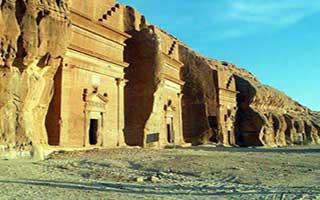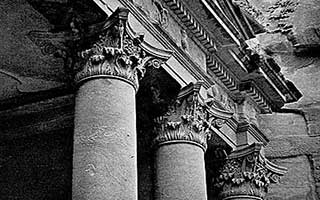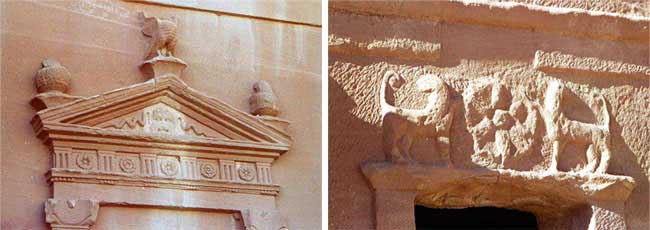The Thamud (also) rejected (their) Warners. For they said: What! a man! a Solitary one from among ourselves! shall we follow such a one? Truly should we then be straying in mind, and mad! Is it that the Message is sent to him, of all people amongst us? Nay, he is a liar, an insolent one! Ah! they will know on the morrow, which is the liar, the insolent one! (Surat al-Qamar: 23-26)
As stated in the Qur’an, Thamud rejected the warnings of Allah just as ‘Ad did and perished in consequence. Today, as a result of archaeological and historical studies, many previously unknown things have been brought to light, such as the location where Thamud lived, the houses they made and their life-styles. The Thamud mentioned in the Qur’an, are a historic fact confirmed by many archaeological finds today.
Before looking at these archaeological finds related to Thamud, it is useful to examine the story in the Qur’an and to look over the struggle of these people with their prophet. As the Qur’an is a book addressing all times, Thamud’s denial of the warnings coming to them is an incident which is itself a warning to people of all ages.
In the Qur’an, it is mentioned that Salih (as) was sent to Thamud to warn them. Salih was a recognised person within the Thamud society. His people, who did not expect him to proclaim the religion of truth, were surprised by his calling on them to abandon their deviation. Their first reaction was to slander and condemn him:
To the Thamud People (We sent) Salih, one of their own brethren. He said: O my people! Worship Allah: ye have no other god but Him. It is He Who hath produced you from the earth and settled you therein: then ask forgiveness of Him, and turn to Him (in repentance): for my Lord is (always) near, ready to answer.They said: O Salih! thou hast been of us! a centre of our hopes hitherto! dost thou (now) forbid us the worship of what our fathers worshipped? But we are really in suspicious (disquieting) doubt as to that to which thou invitest us. (Surah Hud: 61-62)
 |
| From the Qur’an, it is understood that Thamud were the descendants of ‘Ad. In agreement with that, archaeological |
A small part of the community complied with Salih’s (as) call, but most of them did not accept what he told. The leaders of the community in particular denied Salih (as) and took an antagonistic stand towards him. They tried to impede those who believed Salih (as) and tried to oppress them. They were enraged at Salih (as), because he called them to worship Allah. This rage was not specific only to Thamud; Thamud were repeating the mistake made by the people of Nuh (as) and by Ad’ who had lived before them. This is why the Qur’an refers to these three communities as follows:
Has not the story reached you, (O people!), of those who (went) before you? - of the people of Prophet Nuh, and 'Ad, and Thamud? - And of those who (came) after them? None knows them but Allah. To them came messengers with Clear (Signs); but they put their hands up to their mouths, and said: We do deny (the mission) on which ye have been sent, and we are really in suspicious (disquieting) doubt as to that to which ye invite us. (Surah Ibrahim: 9)
Despite the Prophet Salih’s (as) warnings, the people continued in their ways on overcome by doubts. But still, there was a group who believed in the prophethood of Salih (as) – and those were the ones who were saved along with Salih (as) when the great catastrophe came. The leaders of the community tried to oppress the group believing in Salih (as):
The leaders of the arrogant party among his people said to those who were reckoned powerless - those among them who believed: know ye indeed that Salih is a messenger from his Lord? They said: We do indeed believe in the revelation which hath been sent through him. The Arrogant party said: For our part, we reject what ye believe in. (Surat al-A‘raf: 75-76)
Thamud still continued in doubt regarding Allah and the prophethood of Salih (as). Moreover, a certain group openly denied Salih (as). A group among those who rejected faith - supposedly in the name of Allah - made plans to kill Salih (as).
They said: Ill omen do we augur from thee and those that are with thee. He said: Your ill omen is with Allah; yea, ye are a people under trial. There were in the city nine men of a family, who made mischief in the land, and would not reform. They said: Swear a mutual oath by Allah that we shall make a secret night attack on him and his people, and that we shall then say to his heir (when he seeks vengeance): 'We were not present at the slaughter of his people, and we are positively telling the truth.' They plotted and planned, but We too planned, even while they perceived it not. (Surat an-Naml: 47-50)
To see whether his people would follow Allah’s commands, Salih (as) showed them a female camel as a trial. To see whether they would obey him or not, he told his people to share their water with this female camel and not to harm her. His people reacted by killing the camel. In Surat ash-Shu’ara, the events are described as follows:
The Thamud (people) rejected the messengers. Behold, their brother Salih said to them: Will you not fear (Allah)? I am to you a messenger worthy of all trust. So fear Allah, and obey me. No reward do I ask of you for it: my reward is only from the Lord of the Worlds. Will ye be left secure, in (the enjoyment of) all that ye have here? Gardens and Springs, And corn-fields and date-palms with spathes near breaking (with the weight of fruit)? And ye carve houses out of (rocky) mountains with great skill. But fear Allah and obey me; And follow not the bidding of those who are extravagant, Who make mischief in the land, and mend not (their ways). They said: Thou art only one of those bewitched! Thou art no more than a mortal like us: then bring us a Sign, if thou tellest the truth! He said: Here is a she-camel: she has a right of watering, and ye have a right of watering, (severally) on a day appointed. Touch her not with harm, lest the Penalty of a Great Day seize you. But they ham-strung her: then did they become full of regrets. (Surat ash-Shu’ara: 141-157)
The Prophet Salih’s (as) struggle with his people is told as follows in Surat al-Qamar:
The Thamud (also) rejected (their) Warners. For they said: What! a man! a Solitary one from among ourselves! shall we follow such a one? Truly should we then be straying in mind, and mad! Is it that the Message is sent to him, of all people amongst us? Nay, he is a liar, an insolent one! Ah! they will know on the morrow, which is the liar, the insolent one! For We will send the she-camel by way of trial for them. So watch them, (O Salih), and possess thyself in patience! And tell them that the water is to be divided between them: Each one's right to drink being brought forward (by suitable turns). But they called to their companion, and he took a sword in hand, and hamstrung (her). (Surat al-Qamar: 23-29)
The fact that they were not punished at that very moment, increased the insolence of these people more. They attacked Salih (as), criticised him and accused him of being a liar .
Then they ham-strung the she-camel, and insolently defied the order of their Lord, saying: O Salih! bring about thy threats, if thou art a messenger (of Allah)! (Surat al-A‘raf: 77)
Allah rendered the plans and stratagems of the unbelievers feeble and saved Salih (as) from the hands of those who wanted to do him harm. After this event, seeing that he had proclaimed the message to his people in many different ways and that still nobody took the advice to heart, Salih (as) told his people that they would be destroyed in three days:
But they did ham-string her. So he said: Enjoy yourselves in your homes for three days: (Then will be your ruin): (Behold) there a promise not to be belied! (Surah Hud: 65)
Sure enough, three days later, Salih’s (as) warning came true and the Thamud were destroyed.
The (mighty) Blast overtook the wrong-doers, and they lay prostrate in their homes before the morning - As if they had never dwelt and flourished there. Ah! Behold! For the Thamud rejected their Lord and Cherisher! Ah! Behold! removed (from sight) were the Thamud! (Surah Hud: 67-68)
 |
| Petra Valley |
Of those nations mentioned in the Qur’an, Thamud are some of the people about whom we have the most extensive knowledge today. Historical resources reveal that a people called Thamud indeed existed.
The community of al-Hijr mentioned in the Qur’an are thought to be the same people as Thamud. The other name of Thamud is “Ashab al-Hijr”. So, the word Thamud is the name of a people, while the city of al-Hijr is one of those cities founded by these people. The Greek geographer Pliny’s descriptions agree with this. Pliny wrote that Domatha and Hegra were the locations where Thamud resided, and this latter makes up the city of Hijr today.29
The oldest sources known referring to Thamud, are the victory annals of the Babylonian King, Sargon II (eighth Century BC), who defeated these people in a campaign in northern Arabia. The Greeks also refer to this people as Tamudaei, i.e. Thamud, in the writings of Aristo, Ptolemy, and Pliny.30 Before the Prophet Muhammad (saas), approximately between 400-600 AD, they totally disappeared.
In the Qur’an, ‘Ad and Thamud are always mentioned together. Moreover, the verses advise Thamud to take warning from the destruction of ‘Ad. This shows that Thamud had detailed information on ‘Ad.
To the Thamud people (We sent) Salih, one of their own brethren: He said: O my people! worship Allah: ye have no other god but Him (Surat al-A‘raf: 73)
And remember how He made you inheritors after the 'Ad people and gave you habitations in the land: ye build for yourselves palaces and castles in (open) plains, and carve out homes in the mountains; so bring to remembrance the benefits (ye have received) from Allah, and refrain from evil and mischief on the earth. (Surat al-A‘raf: 74)
 |  |
|
The Nabataeans, which was an Arab tribe, had established a kingdom in the Rum Valley in Jordan. In this place, also called the Valley of Petra, it is possible to see the best examples of the stone-carving work of these people. Also in the Qur’an, Thamud are mentioned with their mastery of masonry. However, today, what is left of both of these communities are some remains that give us an idea of the art of that time. In the pictures, various examples of the stone-carving work in Petra Valley are seen. |  |
As understood from this verse, there is a relationship between ‘Ad and Thamud, and ‘Ad may even have been a part of Thamud’s history and culture. Salih (as) ordered Thamud to remember the example of ‘Ad and to take warning from them.
‘Ad were shown the example of Nuh’s (as) people who had lived before them. Just as ‘Ad had an historical importance for Thamud, Nuh’s (as) people also had an historical importance for ‘Ad. These people were aware of each other and possibly came from the same lineage.
 |
However, the places where ‘Ad and Thamud lived were geographically quite far from each other. There does not seem to be a relationship between these two communities; so why is it said in the verse addressed to Thamud for them to remember ‘Ad?
The answer reveals itself after a short investigation. The geographical distance between the ‘Ad and Thamud is deceptive. Historical sources reveal that there is indeed a very strong connection between Thamud and ‘Ad. Thamud knew ‘Ad, because these two peoples most likely came from the same origin. Britannica Micropaedia writes about these people as follows under the title of Thamud:
In ancient Arabia, tribe or group of tribes that seem to have been prominent. Although the Thamud probably originated in Southern Arabia, a large group apparently moved northward at an early date, traditionally settling on to the slopes of Jabal (Mount) Athlab. Recent archaeological work has revealed numerous Thamudic rock writings and pictures not only on Jabal Athlab, but also throughout Central Arabia.31
A script graphically similar to the Smaitic alpabet (called Thamudic) has been found in southern Arabia and up throughout the Hijaz.32 The script was first identified in a region in north central Yemen that is known as Thamud, which is bound to the north by the Rub’al Khali, to the south by the Hadramaut and to the west by Shabwah.
Before, we had seen that ‘Ad were a people living in South Arabia. It is very significant that some remains of Thamud were found in the region where ‘Ad had lived, especially around the region where the Hadramites, the descendants of ‘Ad, lived and where their capital city stood. This situation explains the ‘Ad-Thamud relationship noted in the Qur’an. This relationship is explained as follows in the Prophet Salih’s (as) words revealed in the Qur’an when he said that Thamud came to replace ‘Ad.
To the Thamud people (We sent) Salih, one of their own brethren:
He said: O my people! worship Allah: ye have no other god but Him... (Surat al-A‘raf : 73)
And remember how He made you inheritors after the 'Ad people and gave you habitations in the land (Surat al-A‘raf: 74)
Briefly, in return paid the price for not obeying their messenger, Thamud were destroyed. The buildings they had built and the works of art they had produced could not protect them from punishment. Thamud were destroyed with a terrible punishment just like all the other peoples both before and after them who denied the Truth.
 |
| And remember how He made you inheritors after the 'Ad people and gave you habitations in the land: ye build for yourselves palaces and castles in (open) plains, and carve out homes in the mountains; so bring to remembrance the benefits (ye have received) from Allah, and refrain from evil and mischief on the earth. |
29. Hicr, Islam Ansiklopedisi: Islam Alemi, Tarihi,Cografya, Etnografya ve Bibliyografya Lugati,(Encyclopedia of Islam: Islamic World, History,Geography, Ethnography, and Bibliography Dictionary) Vol. 5/1, p. 475
30. Philip Hitti, A History of the Arabs, London: Macmillan, 1979, p. 37
31. Thamuds, Britannica Micropaedia, Vol. 11, p.672
32. Brian Doe, Southern Arabia, Thames and Hudson, 1971, pp. 21-22